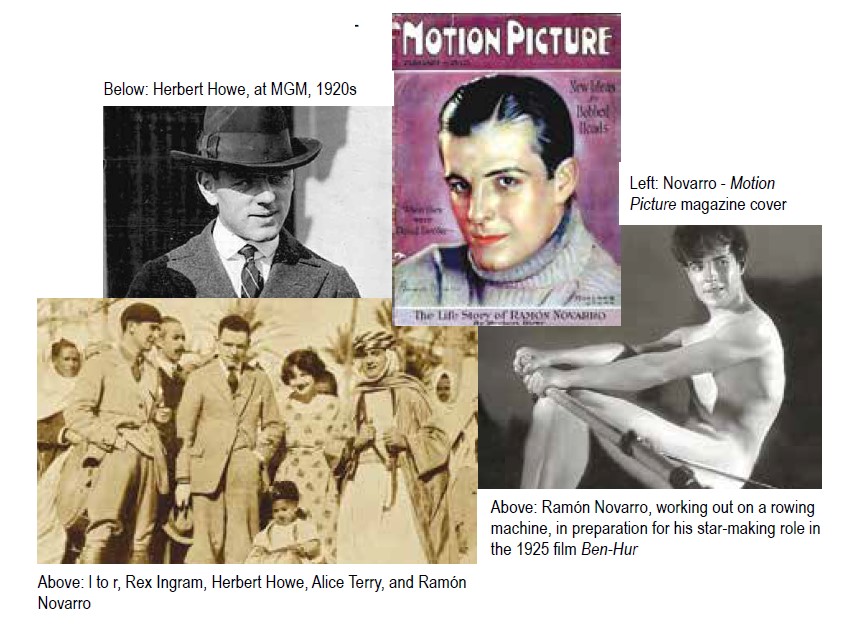
By Dr. Bill Lipsky–
Theirs was one of the great romances of the golden age of the silent screen. The movie-going public, however, who then wanted to know everything about the stars, never learned about it. Had Hollywood publicist and widely popular fan magazine correspondent Herbert Howe written of his ongoing affair with Ramón Novarro, one of the era’s most celebrated and desired film personalities, he would have had the biggest scoop of his career. He also would have ended both their professional lives.
During the 1920s and 1930s, Howe not only wrote about the stars, but he also appeared in stories others filed. He was a major Hollywood personality himself, who “knows everybody worth knowing in pictures.” Readers regularly learned about his imaginary girlfriends and his invented romances with some of the most famous leading ladies of the time. He was, according to Adela Rogers St. Johns in a 1923 article in Photoplay, a “Lothario, this playboy of the movie world,” but she added, “He is a bachelor—from choice.”
Although he always maintained his image as a sophisticated, urbane Hollywood boulevardier, Howe was born in Sioux Falls, South Dakota, on September 28, 1893. After graduating from the State University, he first worked as a film publicist, then turned to writing for “the fannies.” Even with competition from the Parsons, Louella and Harriet, and such literary luminaries as Somerset Maugham and Theodore Dreiser, some believe he was “the best fan magazine writer of the time—arguably of all time.”
Howe knew exactly what the stars were doing, both inside and away from the studios. He could not always state exactly what that was, but he could imply it and did. As early as 1923 he was writing about “the movie boys” who were “all racing around wearing spit curls, bobbed hair, and silk panties.” Perhaps Valentino, the great “Latin Lover,” could get away with it. The screen’s other leading men, he advised, needed to stop. “The public can stand just so many ruffles and no more.”

To support his case, Howe singled out happily married Charles Ray, famous for portraying young, wholesome “country bumpkins” in silent comedies; leading man Richard Barthelmess; and up and coming “heart throb” Ramón Novarro, who “is Scaramouching around Hollywood dressed up like Caesar’s pet horse.” “The boys,” he concluded, “had better walk up one flight and get some blue serge nifties. It’s a cinch if they don’t change their panties some of the producers are going to lose theirs.”
Late in 1923, Howe sailed to Europe on the Majestic. Novarro, born on February 6, 1899, also was on board, traveling to Tunis to make The Arab on location. Silk panties or not, by the time the production finished, the two men were lovers. Speaking with a smitten heart, he told his readers in the May 1924 issue of Photoplay, “Of all the young cinema celebrities Ramón Novarro is … the most worth knowing,” calling him “our finest romantic actor.”
“Think of any great role,” Howe wrote of his new dear friend, “and you’ll think of Novarro: Romeo, Ben Hur, Dorian Grey [sic], Galahad.” He was equally effusive about Novarro’s physical beauty and sensual charisma. “If he ever visits the Vatican, the Apollo Belvedere is going to get down from his pedestal and apologize for having taken up so much time.” Many of his readers, mostly women, agreed, although he did not mention that where they failed to romance him, he had succeeded.
Novarro never played the part of Dorian Gray, but he did get the title role in Ben Hur, the most coveted part in the most prestigious—and most expensive—motion picture of the 1920s. He and Howe returned together to Europe on the Leviathan in 1925 to film it, traveled the continent, and were presented to the king and queen of Italy. “The Italian girls went wild over [him],” Howe informed his readers, but “the romantic young actor never gave them a tumble.”
The reason? “He was too busy trying to make a success of his role.” Meanwhile, he found the time to visit Paris, Monte Carlo, Naples, and Florence with his new intimate companion. Women pursued him everywhere, but according to Howe, Novarro remained aloof because he “holds an idealistic, almost fanciful regard, for [them].” He “believes that women must be wooed long and ardently under balconies” and is “rather taken back when the fair ones hurl themselves over the balustrade at the first romantic glance.” Indeed.
Howe, who also became the actor’s publicist, eventually wrote a series of four long articles about him for Motion Picture Magazine in 1927. Titled “On the Road with Ramón Novarro,” they supposedly told the story of the actor’s life. At the same time, he told those who could read his meaning the truth, giving them at least some of the reasons he saw Novarro almost every day and they even vacationed together.
Howe remembered how their friendship began: “I must have touched a secret spring to his confidence, for that evening was one of charmed revelation,” although he did not mention who charmed whom or what was revealed. He also shared Novarro’s ongoing allure, describing his eyes as “a brilliance in black and white … illuminating a face of Spanish pallor. [They] so mesmerize a mood that you forget to listen.” Of course, he also “has looks, manliness, physique, high ideals, and common sense,” in that order.
Howe never mentioned in any of his reporting when and why their romance ended. After 1935 he only published occasionally, but once again became Novarro’s publicist in the mid 1950s. He died on October 12, 1959. Novarro never retired from acting, but his career faded to ever smaller parts in less and less successful films across the 1930s and 1940s. He was lost on October 30, 1968, murdered by two hustlers in a scandal more shocking than any his love affair with Howe would have caused 40 years earlier.
Bill Lipsky, Ph.D., author of “Gay and Lesbian San Francisco” (2006), is a member of the Rainbow Honor Walk board of directors.
Published on March 11, 2021
Recent Comments